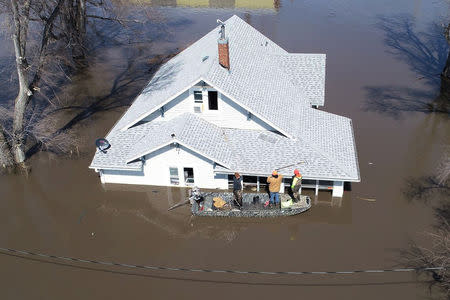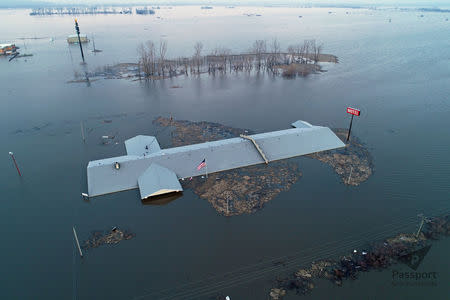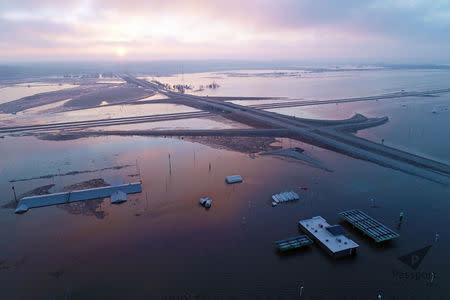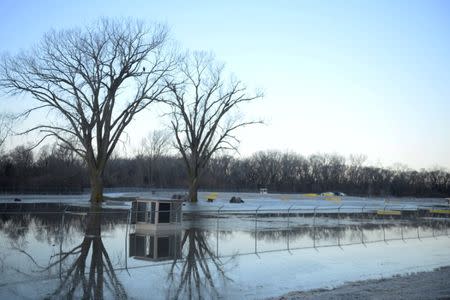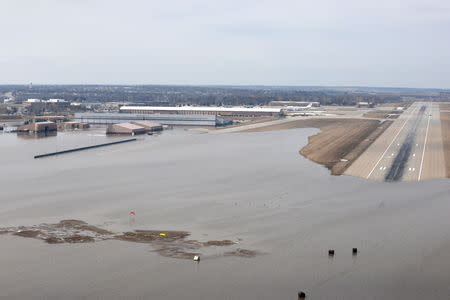Three dead, one missing in devastating floods across U.S. Midwest
(Reuters) - At least one person was missing on Monday after devastating floods across the U.S. Midwest that killed three others and inflicted hundreds of millions of dollars in damage in what Nebraska's governor called a disaster of historic proportions.
As floodwaters began to recede in much of the area inundated by the aftermath of a storm dubbed a "bomb cyclone," Nebraska officials were taking in the damage in a state where 64 of the 93 counties have declared emergencies.
"This is clearly the most widespread disaster we have had in our state's history," in terms of sheer size, Governor Pete Ricketts told reporters on an afternoon briefing call.
State officials said on the call that 290 people had been rescued by the Nebraska State Patrol, National Guard troops, and urban search and rescue teams.
Damage to the state's livestock sector was estimated at about $400 million, while the full impact on the spring planting season was not yet clear, said Steve Wellman, director of the Nebraska Department of Agriculture.
The state's highway system suffered hundreds of millions of dollars in damage, said Kyle Schneweis, director of the state Department of Transportation, with more than 200 miles of roadways needing repair or replacement. Some 540 miles of highways remained closed, he said, down from 1,500 at the peak of flooding.
The three known fatalities included an 80-year-old woman who perished at her Columbus, Nebraska, home, despite attempts to rescue her from rising floodwaters, said Colonel John Bolduc of the Nebraska State Patrol.
Bolduc said a young man from Norfolk, Nebraska, was swept away and killed after driving his car into moving water, and a Columbus man died when the tractor he was using to help free a stranded driver overturned.
One person was missing and presumed dead following the collapse of the Spencer Dam along Niobrara River in southwest Nebraska, Buldoc said.
VICE PRESIDENT TO VISIT
The Missouri River, the longest in North America, has flooded much of Nebraska between Omaha and Kansas City at the Missouri state line.
The river was expected to crest at 47.5 feet (14.48 m) on Tuesday, breaking the previous record, set in 2011, by more than a foot, the Nebraska Emergency Management Agency said in the latest bulletin on its web page.
Ricketts said he had requested emergency assistance from the Federal Emergency Management Agency and been in contact with the Trump administration.
Vice President Mike Pence would travel to Nebraska on Tuesday to survey the damage, White House spokeswoman Sarah Sanders said on Twitter. Ricketts and Iowa Governor Kim Reynolds have both declared states of emergency
The Missouri River's overflowing banks cut off roads leading to the Cooper nuclear plant, near Brownville, Nebraska, forcing operators to fly in staff and supplies by helicopter. The plant continued to operate safely, its operator said.
Water also covered one-third of that state's Offutt Air Force Base, near Bellevue, home to the U.S. Strategic Command.
At least 30 buildings were flooded by up to eight feet of water and 30 more structures damaged on the base, the Omaha World-Herald reported, citing a base spokeswoman.
The National Weather Service reported some of the region's larger rivers were running at record high levels, causing levee breaks. Some small towns and communities have been cut off by floods while others were short of fresh drinking water.
Streets in Lincoln, Nebraska's capital, were barely visible as high water surrounded homes, cars and trees, according to photos released to Reuters by state authorities. Elsewhere in the state, one highway near Waterloo was submerged, and piles of debris and damaged roads were visible in Niobrara.
Floodwater climbed up the sides of buildings at Camp Ashland, an Army National Guard facility in Ashland, Nebraska.
Warmer temperatures will speed the pace of snow melt across the region and add to already swollen rivers, the NWS said, possibly forcing more evacuations in communities along the Missouri River on the Nebraska and Iowa border, as well as along the Elkhorn and Platte rivers in Nebraska.
"There could be issues across portions of Nebraska and Kansas for the next seven days," NWS meteorologist Jim Hayes said.
(Reporting by Gina Cherelus in New York, Rich McKay in Atlanta and Dan Whitcomb in Los Angeles; Writing by Dan Whitcomb; Editing by Bill Tarrant and Leslie Adler)

